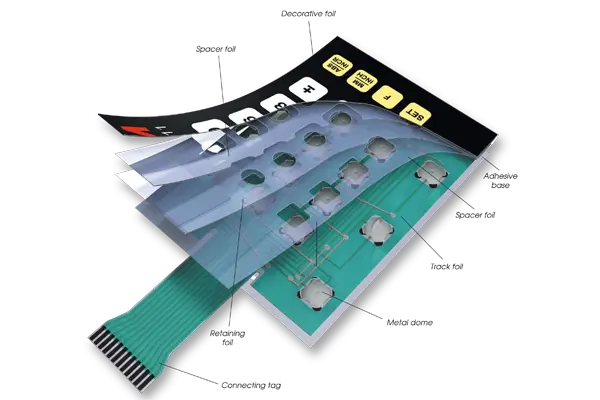Introduction of the Keypad Membrane
A keypad membrane is a common input device in many electronic systems, offering durability, versatility, and reliability. From calculators to industrial control panels, membrane keypads provide an effective means of sending signals to microcontrollers or other electronic components. This article explores how these keypads operate and the key advantages that make them suitable for various applications.
Structure and Functionality of a Keypad Membrane
A keypad membrane consists of several layers of plastic and conductive materials. These include a top plastic sheet, a conductive layer, an insulating layer, and a bottom plastic layer. When a key is pressed, the flexible sheet makes contact with the conductive layer, enabling the device to detect the input through electrical conduction.
Conductive Paths and Signal Detection
The conductive layer beneath the keypad is made up of paths connected to a microcontroller. When a user presses a key, a conductive path is established, allowing the signal to reach the microcontroller. This interaction forms the basis of how membrane keypads operate.
Role of the Insulating Layer
The insulating layer plays a crucial role in preventing short circuits. This layer, typically made of plastic or rubber, separates the conductive paths from one another. It ensures that only the specific key pressed makes contact with the conductive path, preserving the proper function of the device.
The Principle of Electrical Conduction
The keypad membrane operates on the principle of electrical conduction. When a key is pressed, it creates a conductive path between the key and the microcontroller. This signal is then interpreted by the microcontroller, allowing the system to perform the desired action based on the input.
Durability of Keypad Membrane
One of the key advantages of keypad membrane is their durability. The flexible plastic construction resists wear and tear, while the insulating layer protects the conductive paths. These features ensure that membrane keypads can handle frequent use over time.
Versatility Across Applications
Membrane keypads are not only durable but also highly versatile. They are commonly found in calculators, remote controls, and industrial panels. Additionally, their use extends to medical devices like glucose meters and consumer electronics such as televisions and DVD players.
Conclusion of Keypad Membrane
In conclusion, keypad membrane offer a simple yet effective means of input in a wide range of devices. Their operation relies on the basic principles of electrical conduction and insulation, making them both durable and cost-effective. From consumer electronics to industrial and medical applications, membrane keypads remain a popular choice due to their versatility and reliability.
Membrane Keypad FAQ
1. What is a membrane keypad?
A membrane keypad is a type of input device commonly used in electronic equipment such as calculators, remote controls, and industrial control panels. It consists of a flexible plastic sheet with conductive and insulating layers that detect when a key is pressed.
2.How does a membrane keypad work?
When a key is pressed, it creates a conductive path between the key and a microcontroller. This allows the device to detect the input and trigger the corresponding action based on electrical conduction principles.
3.What materials are used in a membrane keypad?
The keypad membrane is made of multiple layers: a top plastic sheet, a conductive layer with paths connected to a microcontroller, an insulating layer to prevent short circuits, and a bottom plastic layer.
4.Why is the insulating layer important?
The insulating layer prevents conductive paths from making unwanted contact, avoiding short circuits and ensuring the device functions correctly.
5.What are the advantages of using a membrane keypad?
Membrane keypads are durable, resistant to wear and tear, cost-effective to manufacture, and versatile enough for various applications.
6.Where are membrane keypads commonly used?
They are used in devices like calculators, remote controls, industrial control panels, medical equipment (such as glucose meters), and consumer electronics like televisions.
7.What makes membrane keypads durable?
The flexible plastic and protective insulating layer make membrane keypads resistant to damage, allowing them to withstand frequent use.
8.Are membrane keypads expensive?
No, membrane keypads are relatively inexpensive to manufacture, making them a cost-effective solution for many electronic devices.
9.Can keypad membrane be used in medical devices?
Yes, they are commonly used in medical devices like blood pressure monitors and glucose meters due to their reliability and ease of use.

